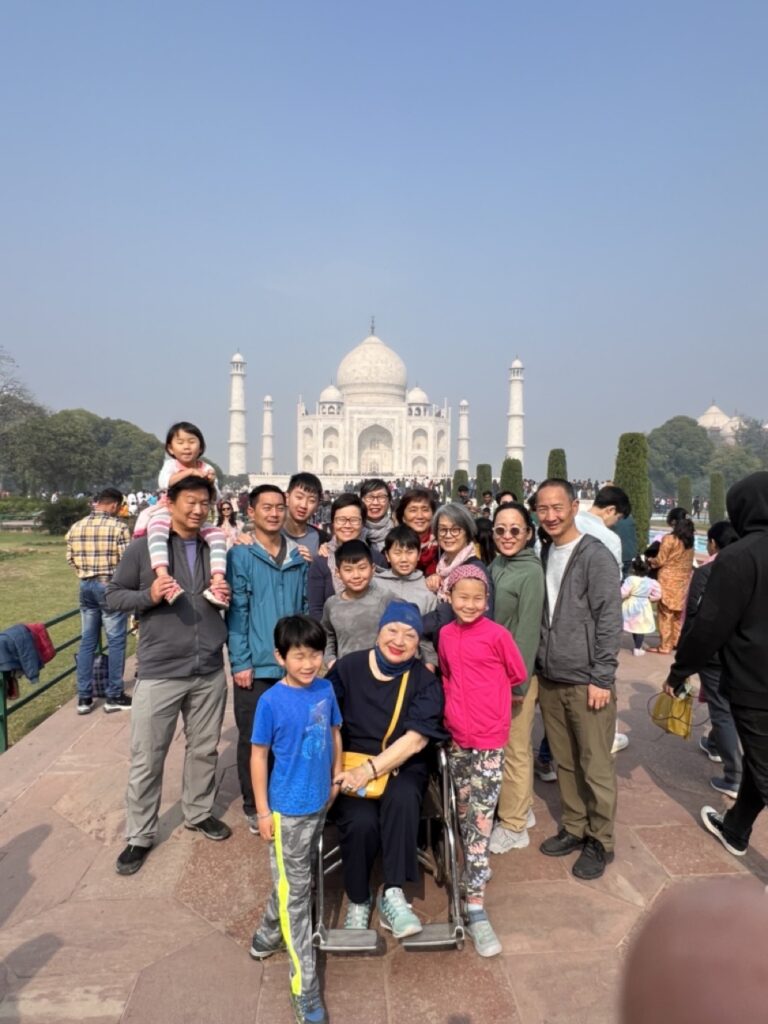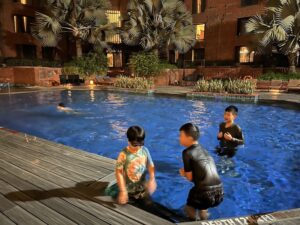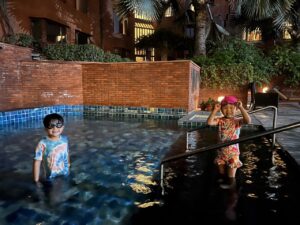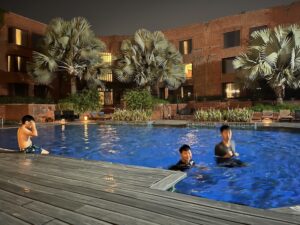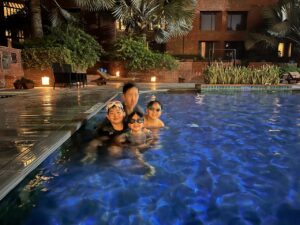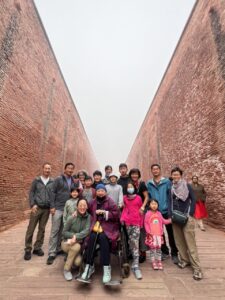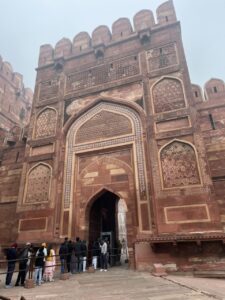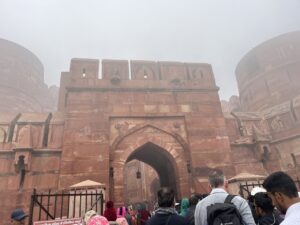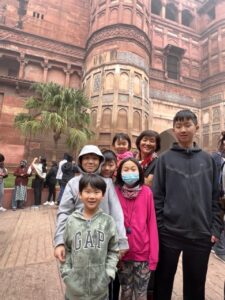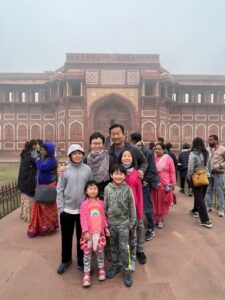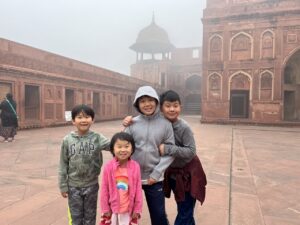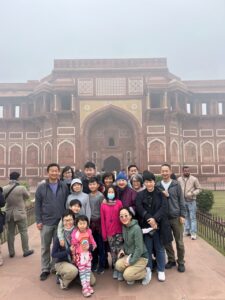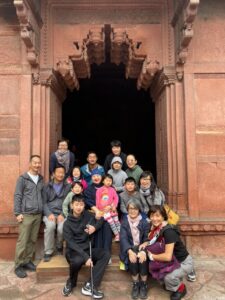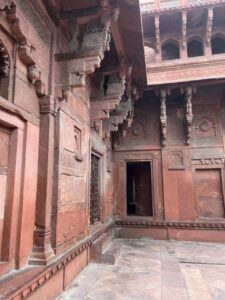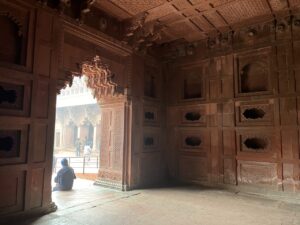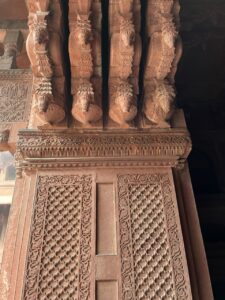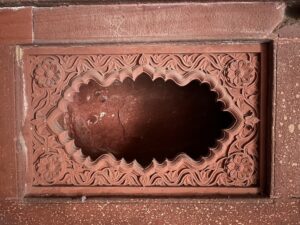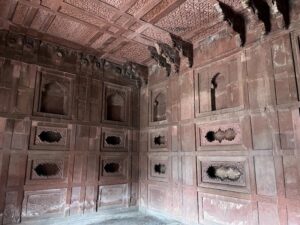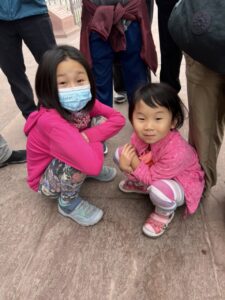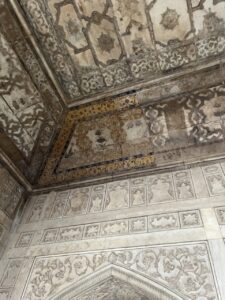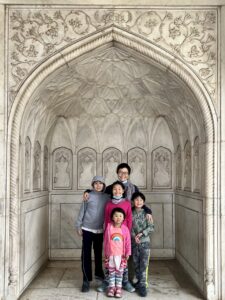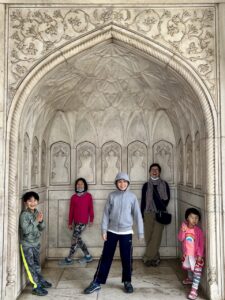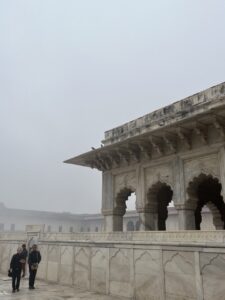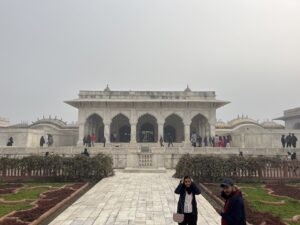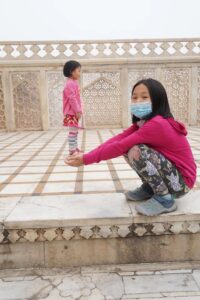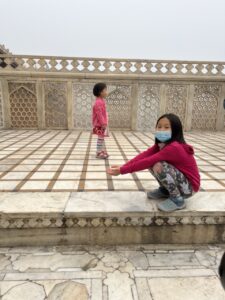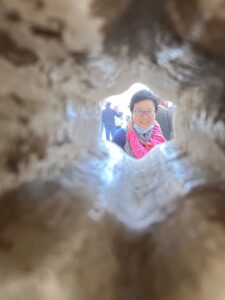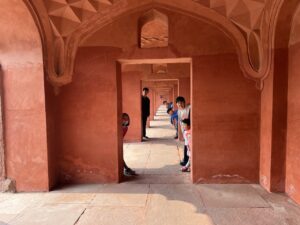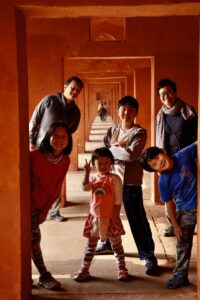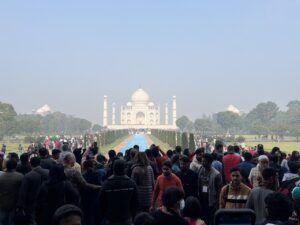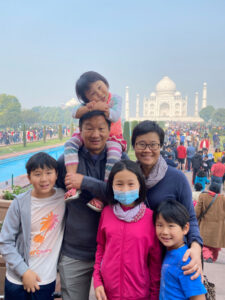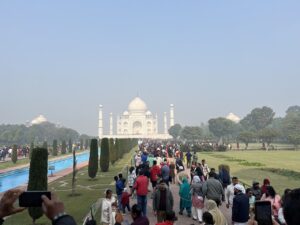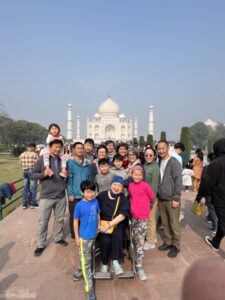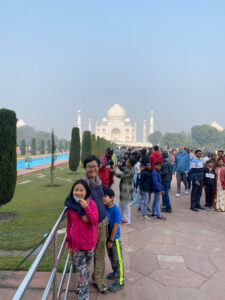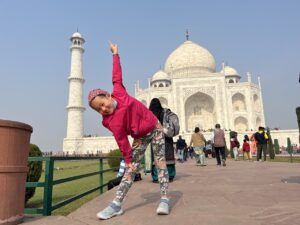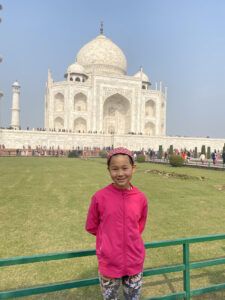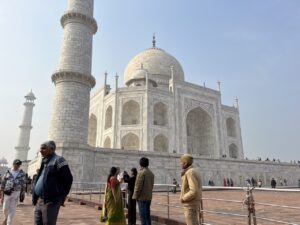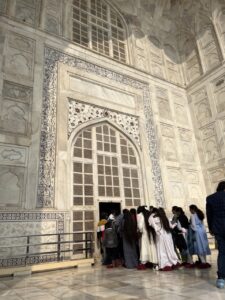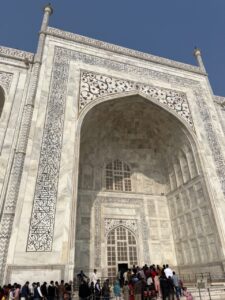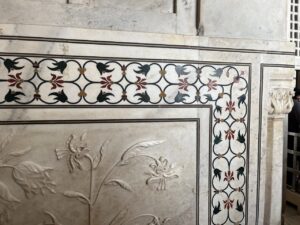Somehow, the 4-hour drive from New Delhi to Agra turned into 7-hours. I have no idea how that happened. Did the traffic and bathroom stops really add an extra 3 hours to our journey? Rajesh didn’t seem to be surprised and since the driver didn’t speak English, we just left it at that.
We were relieved and exhausted when we arrived at the ITC Mughal Hotel. We were hoping for a warm welcome but it was more like lukewarm. It took forever for the front desk to check us in and hand over our keys. Checking in is not something that should be difficult. But for some reason, easy things seem to have become increasingly difficult since we got to India. On the one hand, the impossible can be made possible. On the other hand, routine processes seem to take an incredibly long time and involve an unreasonable number of people.
Even though it was past check in time, the uncooperative and barely competent Front Desk staff tried to tell us that one of the rooms wasn’t ready and asked us to wait in the lobby. It wasn’t until Leo demanded to speak to the Front Desk Manager that our rooms were quickly sorted out.
We got settled in our rooms and rested for a few minutes before we headed out again for an early dinner, to a South Indian dosa restaurant. We weren’t in the mood for anything too heavy or intense, so dosas turned out to be a good choice. Everybody found something that they liked. The younger kids liked the plain dosas while we liked the potatoes dosa served with spicy sambar and chutneys.
When we got back to the hotel that night, the kids were intent on going swimming. We had such a busy sightseeing schedule in New Delhi that we hadn’t had a chance to swim in the pool at Taj Hotel. The kids weren’t going to risk missing the chance to swim again. Even though the weather was chilly, the kids went ahead as planned and changed into their swimming suits. We walked down to the pool and even the frigid water did nothing to dampen their enthusiasm. Despite the conditions, the boys jumped into the water one by one. AY and EY were more susceptible to the cold and stayed mostly dry. I miss the kids as babies, but one thing I definitely don’t miss is having to go in the water whenever they wanted to go swimming.
Almost every first-timer to India goes to the Taj Mahal. There is so much hype and expectation because, like the Pyramids of Giza, the Eiffel Tower and the Statue of Liberty, the Taj Mahal is simply one of the must-see sites in the world. These sites are a testament to human progress, civilization and beauty. In a nutshell, these sites symbolize humanity. What most tourists probably don’t even think about is that even if you make it to the Taj Mahal, you might not actually be able to see it. During certain times of the year, the Taj Mahal is obscured, literally hidden behind smog. This was exactly the situation on the day of our visit.
We had initially planned an afternoon visit because the morning smog in the winter is often the heaviest. Despite the original plan, Rajesh still recommended for us to go in the morning if the right conditions presented themselves. During breakfast, Rajesh continually monitored the weather and smog conditions. This really reminded me of the years that we lived in Beijing. All of our activities and plans for the day were completely subject to the whims of the pollution gods.
The smog wasn’t abating so we postponed our departure time twice. What is the point of visiting the Taj Mahal if you can’t even see it? While we were waiting, Rajesh showed us some videos of the crowds seen at the Taj Mahal that very morning. Smog plus crowds does not equal a good experience. We decided to go to Agra Fort first and save the Taj Mahal for a bit later in the hope that the sun would come out and help cut through the smog and maybe, just maybe, the crowds would die down a little too.
Agra Fort (Red Fort)
The significance and beauty of the Agra Fort is often overshadowed by the Taj Mahal. We fell into that exact mindset in our own scheduling for the day. We hastily shifted around our visit to the Agra Fort, as if it was just a time filler, while we waited for the fog to clear for a view of the Taj Mahal. Agra Fort is located around the bend of the Yamuna River, about 2.5 km west of the Taj Mahal.
In its own right, the Agra Fort is a magnificent Mughal Fort containing a sprawling complex of courtyards, gardens, mosques, palaces and an entire city. Construction on Agra Fort began in the 1565 by Emperor Akbar, the third Mughal ruler, around the same time he was building Humayun’s Tomb in Delhi.
The original construction of Agra Fort was primarily red sandstone, hence its nickname, the Red Fort. Akbar envisioned the fort as a military fortification. Akbar’s grandson, Shah Jahan added to the complex using his favorite building material, white marble, and turned the fort into a palace complex for the royal family. In an ironic twist of fate, Shah Jahan was held under house arrest in Agra Fort by his son, Aurangzeb, who accused him of squandering the treasury on extravagant building projects. Eventually, Aurangzeb seized power from his father and became the sixth Mughal emperor.
We entered Agra Fort through the Amar Singh Gate, one of the four original gates. Originally, this gate was reserved for Emperor Akbar to enter and exit the fort.
We followed the walkway to Jehangir’s Palace, built by Akbar for his son, Jehangir, the fourth Mughal emperor. Everywhere we turned, there are tall pillars, intricate carvings and peaked archways in the red sandstone that show the combination of Indian and Muslim architectural styles.
We explored the Khas Mahal, built of white marble by Shah Jahan.
The Diwan-i-aam, or hall of public audience, and Diwan-i-Khas, or hall of private audience, was where the emperor received visitors and important dignitaries.
By now, we were all losing focus. It was hard to keep track of what we were looking at and where we were going in the maze of halls and courtyards. We simply wandered around enjoying the views and having fun with photos.
By the time we were leaving Agra Fort, the smog had cleared a little and the sun was out.
Taj Mahal
The Taj Mahal is considered to be the absolute pinnacle of Indo-Islamic architecture, a masterpiece. It was built by the Mughal Emperor Shah Jahan as a mausoleum to honor his wife Mumtaz Mahal, who died from childbirth complications in 1631. Construction began in 1632 and the Taj Mahal took 12 years to build. More than 20,000 workers from India, Persia, Europe and the Ottoman Empire along with 1000 elephants were used during construction. The original complex included a mosque, guesthouse and the southern gateway. The outer courtyard and the cloisters were added later.
Besides its undeniable beauty, part of the ever-lasting appeal of the Taj Mahal is the great love story behind its construction. Mumtaz Mahal was the last of Shah Jahan’s three wives. She was a Muslim Persian princess who Shah Jahan fell madly in love with at first sight when he was only 15 years old. The emperor loved her above all others. She was not only his wife and mother to his 14 children but also his best friend, confidant and advisor. She traveled everywhere with him throughout the Mughal Empire. She died from postpartum hemorrhaging after giving birth to their fourteenth child. At her deathbed, Shah Jahan promised to build her the most beautiful tomb the world had ever seen. Shah Jahan fell into a deep depression upon her death and did not emerge from mourning for two years. While in mourning, he began planning the Taj Mahal as a symbol of his undying love.
Legend has it that Shah Jahan had originally intended to build a mausoleum for himself made of black marble across the Yamuna River and connected to the Taj Mahal by a bridge. Shah Jahan’s dream did not come to fruition as he was overthrown by his son, Aurangzeb, who accused him of wasting away the royal treasury with his expensive and frivolous building projects. Aurangzeb imprisoned Shah Jahan for the remainder of his life in Agra Fort in a room with a view of the Taj Mahal. After Shah Jahan died, he was buried beside his beloved wife in the Taj Mahal.
We approached the Taj Mahal from the eastern gate of the complex. The eastern gate is the one usually used by international tourists while the western gate is more frequently used by locals and is the most crowded. It wasn’t very crowded when we entered into the complex. While everybody else seemed to know exactly where they were going, we meandered around the buildings near the eastern gate and encountered the red sandstone tomb of another of Shah Jahan’s wives.
Both the visitors from the eastern and western gates converged in the gardens. Almost as one body, we walked through an octagonal entrance hall with rooms on either side, made of red sandstone with beautiful white and black marble inlay designs of Koranic verses, design patterns and floral motifs. As we left the entrance hall behind, the gleaming white marble of theTaj Mahal appeared before us like a dream. It was still smoggy, but just as we had hoped, the sun was out, helping to dissipate the pollution.
Upon first sight of the Taj Mahal, everybody instinctively stopped at this point to take photos. The view was indeed stunningly beautiful. The Taj Mahal appeared other-worldly, like it was deposited in its place by aliens. The still whiteness of the marble was such a contrast to the colors of life surrounding it, making the Taj Mahal look ethereal and transcendent.
At this point, there was only one obvious path, through the perfectly symmetrical charbagh, or Paradise Gardens. Charbagh is a Persian-style garden layout where the garden is divided into four equal quadrants that are delineated by walkways and/or water fountains. The fountains weren’t in operation and that seems not to be unusual. The main building, in this case the Taj Mahal, is situated at the center of the garden. There is no getting lost or wandering off because it is just a straight shot to the Taj Mahal with the mausoleum constantly in view.
The exterior views of the Taj Mahal are known throughout the world. Perfectly symmetrical, perfectly beautiful. We were about to see what was actually inside the building. We joined a long line that snaked up the stairs and around the mausoleum. Once we got closer, Rajesh passed out shoe coverings that are required to step into the marble courtyard of the mausoleum. Nobody enjoyed being in the line. It was at times disorderly and we seemed to constantly be under the sun. While we were waiting in line, we got to look closely at some of the intricate inlay work that could only be done by master craftsmen. Around the portico of the entrance are written verses from the Koran that appear consistently sized due to an optical refinement. To make the writing appear the same size to an observer standing at ground level, the actual size of the writing becomes gradually larger the higher up it is.
It took about 45 minutes to reach the entrance of the mausoleum, where photography is not allowed. DY had been complaining just about the whole time with increasing vigor. He was probably getting hungry, annoyed by the crowds and resentful of waiting for something he didn’t even want to see. By the time we reached the entrance of the mausoleum, despite the blinding whiteness of the marble, all he could see was red.
The interior of the mausoleum is an octagonal room dizzying in its use of geometric designs. Everywhere is white marble accented with pietra dura (inlaid with semi-precious stones like lapis lazuli, jasper and carnellian). There are marble lattice screens enclosing the cenotaphs (empty tombs) of Mumtaz Mahal at the center and slightly offset to the side, Shah Jahan. The pair are actually buried at garden level in a chamber below. The cenotaph of Shah Jahan is the singular aspect of the Taj Mahal that is not symmetrical because he had originally planned for himself to be buried in another mausoleum, not the Taj Mahal. His placement in the Taj Mahal was not part of the original design.
People were crowded into the mausoleum, body to body, trying to get a glimpse of the cenotaphs and the fine craftsmanship that was visible in the detailed inlay work. It was hot and stuffy and DY was losing it.
DY is usually an easy-going guy but sometimes he gets into these moods. Often, they have something to do with him being hungry or provoked. When he gets like this, I know I need to keep him close to me or he might just do something both of us regret. I was multi-tasking, trying to notice everything that I could in a place that I would probably never have the chance to visit again. Simultaneously, I was trying to help DY keep his head above water. DY couldn’t see anything apart from his impatience and anger. Under his breath, he murmured to himself, spewing negativity just loud enough so that I could hear every word. I didn’t know how much longer either of us could endure this without exploding. Who knows how many rooms there were or how long it would take. Everybody was faithfully following the person in front of them without really knowing what was ahead. In my most cheerful voice, I suggested to DY that we cut out early and head back down to the garden and find a shady place to sit.
Defiantly, he sneered, “No! That won’t make it better!”
“Why not?” I snapped back. My impatience was also coming to a head.
As he spoke the following words, his face contorted like he was in physical pain. “Because then you won’t get to see it.”
The tears were already forming in my eyes. I looked at my son and realized that all this while, he was trying his best to hold all those negative feelings of anger, annoyance and impatience inside. But all we could see was what managed to escape his best efforts. I could only see his misbehavior, not his effort.
That exchange immediately dissipated the tension between us. I told DY that I was really touched by what he said. He confirmed that he had been struggling with his emotions, but was trying to hold on because he knew that I really wanted to see the Taj Mahal. At that moment, we realized we were already near the exit of the mausoleum and would be back outside soon.
In a mom’s eyes, there is nothing in the world that I really want, only what I want for my children. DY thought I really wanted to see the Taj Mahal. I did but I didn’t really. The Taj Mahal was just the setting, the place in the world where we happened to be, when DY took one step closer to growing up.
Author
-

Song is the mother of four children. She and her family have stepped away from it all and in September 2023, began traveling the world while homeschooling. Song is an ABC (American born Chinese) and has an undergraduate degree from Cornell and an MBA from Harvard. She is an entrepreneur and an educator. Her hobbies include learning, traveling, reading, cooking and baking, and being with children.

